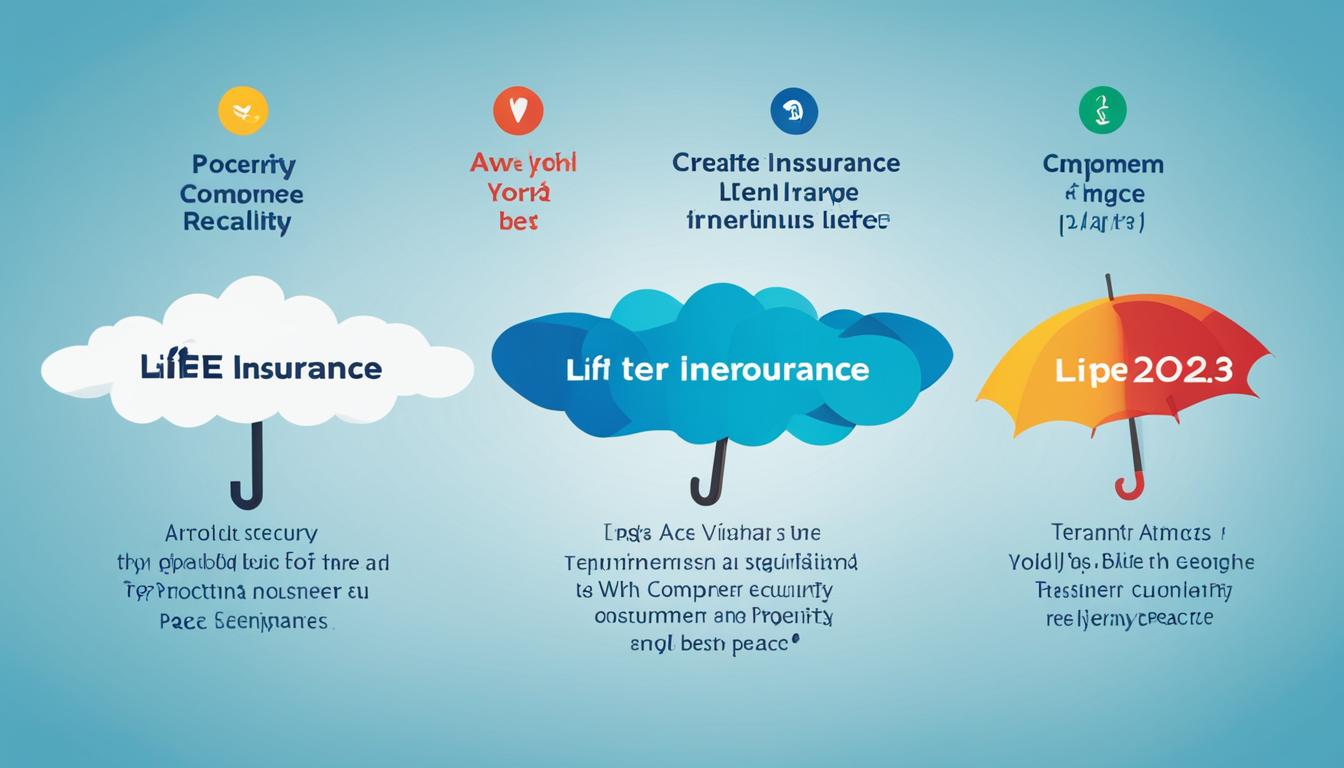A renewable term life insurance policy is a type of term life insurance that includes a clause allowing the policyholder to extend the coverage term without having to re-qualify for new coverage. This clause is contingent on the payment of premiums and a renewal premium by the beneficiary. It is important to note that not all term life insurance policies have a renewable term clause. Renewable term policies provide peace of mind for the possibility of worst-case scenarios and offer guaranteed insurability for a set number of years.
Key Takeaways:
- A renewable term life insurance policy allows the policyholder to extend coverage without re-qualifying for new coverage.
- Renewable term life insurance offers guaranteed insurability for a set number of years.
- Not all term life insurance policies have a renewable term clause.
- Renewable term policies provide peace of mind for worst-case scenarios.
- Renewable term policies offer flexibility and can be beneficial for short-term insurance needs.
How Renewable Term Insurance Works
In a life insurance contract, the renewable term clause offers a valuable feature for policyholders. It allows them to extend the coverage term without the need to go through the entire underwriting process again (Source: XYZ Insurance). This provision is particularly beneficial in situations where future health circumstances are uncertain. By having a renewable term policy, individuals have the flexibility to continue their coverage without the stress of potentially being denied due to a change in their health status.
While renewable term insurance policies may come with higher initial premiums compared to those without a renewable term clause, the advantages far outweigh the costs. The policyholder has the option to renew the policy each year (Source: XYZ Insurance), ensuring continued protection for their loved ones no matter what their health situation may be. This provision is especially valuable if the policyholder’s health deteriorates, as it eliminates the risk of becoming uninsurable.
A renewable term policy typically renews annually, and the premiums are reassessed based on the policyholder’s age at each renewal (Source: XYZ Insurance). This means that the cost of the policy may increase over time as the policyholder gets older. However, this trade-off is well worth it for individuals who need reliable coverage and want to avoid the hassle of re-qualifying for new coverage.
Overall, renewable term insurance provides peace of mind and guaranteed insurability for a set number of years. It gives policyholders the ability to extend their coverage term without the stress of having to navigate the underwriting process again. With this type of policy, individuals can ensure that their loved ones are protected in the event of a worst-case scenario (Source: XYZ Insurance).
By having a renewable term policy, individuals have the flexibility to continue their coverage without the stress of potentially being denied due to a change in their health status.
Key Features of Renewable Term Insurance:
- Flexibility to extend the coverage term without re-qualification
- Peace of mind for uncertain future health circumstances
- Eliminates the risk of becoming uninsurable
- Premiums reassessed annually based on the policyholder’s age
Comparison: Renewable Term Insurance vs. Non-Renewable Term Insurance
| Features | Renewable Term Insurance | Non-Renewable Term Insurance |
|---|---|---|
| Ability to extend coverage term | Yes | No |
| Re-qualification required for extension | No | N/A |
| Cost | Higher initial premiums | Lower initial premiums |
| Flexibility | Higher | Lower |
Key Takeaways
Here are the key takeaways to remember about renewable term life insurance:
- Renewable Coverage: Renewable term life insurance policies allow the policyholder to renew their coverage without the need for new underwriting or re-qualification. This means that as long as the premiums are paid, the policy can be extended without any changes or additional requirements.
- Coverage for Declining Health: Renewable term policies provide coverage even if the insured’s health has declined since the policy was initially issued. While the premiums for renewed coverage will reflect the insured’s older age and potential health risks, the policyholder can still maintain coverage in the face of deteriorating health.
- Age Limitation: Most renewable term life insurance policies have an age limit at which point renewal is no longer an option. Typically, this age limit is until age 70. After reaching this age, policyholders will need to explore other options for coverage.
Note: Renewable term insurance should not be confused with convertible term life insurance. Convertible term life insurance allows the policyholder to convert their term life coverage to whole life coverage at any point during the term or before their 70th birthday.
Understanding these key points about renewable term life insurance can help individuals make informed decisions when considering term life insurance policies and ensuring guaranteed insurability for a set number of years.
Renewable Term Life vs. Convertible Term Life
In the realm of term life insurance, there are two key options that provide flexibility and adaptability: renewable term life insurance and convertible term life insurance.
Renewable term life insurance allows policyholders to extend the current coverage term without the need for re-qualification or additional screening. This means that individuals can continue their coverage for a set period of time, ensuring ongoing protection for their loved ones.
Convertible term life insurance, on the other hand, offers an additional layer of flexibility by providing the option to convert term life coverage into whole life coverage. This conversion can occur at any point during the term or before the insured’s 70th birthday, allowing policyholders to transition from temporary coverage to a permanent life insurance solution.
While both types of insurance serve the purpose of maintaining coverage without re-qualification or additional screening, the key difference lies in the ability to switch to whole life insurance. Renewable term life insurance cannot be converted to whole life coverage, while convertible term life insurance provides the opportunity for this transition.
Whether you choose renewable term life or convertible term life, both options offer peace of mind and financial protection for you and your loved ones. Consider your long-term goals and financial needs to determine the best fit for your situation.

| Renewable Term Life | Convertible Term Life | |
|---|---|---|
| Ability to Extend Coverage | Yes | Yes |
| Switch to Whole Life Insurance | No | Yes |
| Requires Re-Qualification | No | No |
Annual Renewable Term Life Insurance
Annual renewable term (ART) life insurance is a type of renewable term life insurance that renews on an annual basis. These policies offer guaranteed insurability for a set number of years, typically with a level death benefit. The premiums for ART policies are reassessed each year based on the policyholder’s age, so the premiums are likely to increase over time. ART policies are often chosen when short-term life insurance coverage is needed quickly.

Advantages of Annual Renewable Term Life Insurance
When considering life insurance options, ART policies provide several advantages:
- Flexibility: The annual renewal feature allows policyholders to adjust their coverage as needed.
- Short-term coverage: ART policies are ideal for individuals who have temporary insurance needs or anticipate purchasing group life insurance through a future employer.
- Cost-effective: ART policies tend to be more affordable compared to other types of life insurance, making them an attractive option for budget-conscious individuals.
Annual Renewable Term Life Insurance Premiums
One consideration when it comes to ART policies is the reassessment of premiums each year. As the policyholder ages, the premiums are likely to increase. However, the initial premiums for ART policies are typically lower compared to other types of life insurance.
It is important to note that while ART policies offer flexibility and affordability in the short term, the long-term cost of renewing the policy annually may outweigh the benefits. Therefore, individuals should carefully consider their long-term life insurance needs and weigh the cost versus coverage provided by ART policies.
Comparing Annual Renewable Term Life Insurance
When comparing different life insurance options, it’s essential to consider factors such as premium stability, coverage duration, and overall affordability. Here is a comparison table between annual renewable term life insurance and other types of term life insurance policies:
| Factors | Annual Renewable Term Life Insurance | Level Term Life Insurance |
|---|---|---|
| Policy Duration | Renews annually | Same for a specified term (e.g., 10, 20, or 30 years) |
| Premiums | Reassessed yearly, likely to increase with age | Remain level for the term duration |
| Flexibility | Annual renewal option | No flexibility in term duration |
| Coverage Amount | Level death benefit | Level death benefit |
Note: The above table provides a general comparison and may vary based on the specific terms and conditions of insurance policies offered by different providers.
“Annual renewable term life insurance offers flexibility and affordability for those with short-term insurance needs.” – Insurance Expert
How Does Annual Renewable Term Life Insurance Work?
Annual renewable term life insurance is a type of term life coverage that renews every year. It offers policyholders the ability to extend their coverage without the need to reapply or undergo another medical exam. This provides a valuable advantage for individuals who want to maintain their insurability and continue their life insurance protection.
When you purchase an annual renewable term (ART) life insurance policy, you lock in a period of insurability. During this time, typically one year, you have the option to renew the policy without going through the underwriting process again. This means you can continue your coverage without worrying about changes to your health or other factors that may impact your insurability.
One important aspect of annual renewable term life insurance to note is that while the premiums start out relatively low, they increase each year as you age. This is because the risk of insuring an individual typically increases with age. The increase in premiums allows the insurance company to account for this increased risk and continue providing coverage.

The face amount, which is the benefit paid upon death, remains the same throughout the policy’s extension. This means that even though the premiums increase, the amount of coverage or the financial benefit your loved ones will receive remains constant.
It’s important to note that the maximum age for renewal can vary by state and insurance provider. Some states may set the age limit at 80, while others may have different criteria. Be sure to check with your insurance provider to understand the specific terms and conditions of your policy.
Annual renewable term life insurance provides individuals with a flexible and renewable life insurance option. It allows for continued coverage without the need for requalification or additional medical exams, ensuring a seamless and straightforward process for policyholders.
Cost of Annual Renewable Term Life Insurance
The cost of annual renewable term life insurance can vary depending on several factors, including the policyholder’s age, health condition, and the face amount of the policy. Premiums for annual renewable term (ART) policies start off relatively low but increase each year as the policyholder ages. It is important to note that the exact cost of an ART policy can differ between insurance providers and individual circumstances.
When considering the cost of ART life insurance, it is crucial to compare quotes from different providers. This allows you to evaluate the premiums and determine the most competitive rates. Additionally, it’s important to consider the long-term cost of an ART policy, especially if you plan to renew it for multiple years.
Renewing an ART policy every year can lead to higher premiums over time. Therefore, it’s essential to assess your financial situation and budget to ensure that the cost of the policy aligns with your long-term goals and financial capabilities.
Is Annual Renewable Term Life Right for You?
Annual renewable term life insurance may be a good fit if you have short-term insurance needs. This type of policy is especially useful for covering temporary debts or when you are between jobs and anticipate purchasing group life insurance through a future employer.
However, for most people who need life insurance, locking in a term life insurance rate for at least five years or considering a 20- or 30-year level term life policy is a better financial decision. These options provide long-term coverage at a fixed premium for a specified term, offering stability and predictability.
It is worth noting that if you initially choose an annual renewable term policy and later find that you need coverage for a longer period, some insurance companies may allow you to convert your term policy to whole life insurance without a medical exam. This can provide a seamless transition to a more permanent life insurance solution.
Comparing Term Lengths
| Policy Type | Annual Renewable Term Life Insurance | Level Term Life Insurance |
|---|---|---|
| Term Length | Renews annually | Fixed term (e.g., 10, 20, or 30 years) |
| Premiums | Increase each year | Remain the same for the specified term |
| Short-Term Coverage | Yes | No; designed for longer-term coverage |
| Predictability | Low; premiums can increase significantly over time | High; stable premiums for a specified term |
When comparing annual renewable term life insurance to level term life insurance, it is clear that annual renewable term insurance is suitable for short-term insurance needs, while level term insurance is designed for longer-term coverage and offers more stable premiums.
Ultimately, the choice between annual renewable term life insurance and other types of life insurance depends on your individual circumstances, financial goals, and coverage needs. Consulting with a life insurance agent can provide valuable insights and help you make an informed decision.

Advantages of Annual Renewable Term Life Insurance
Annual renewable term life insurance offers several advantages, making it a desirable option for individuals with short-term insurance needs:
- Least Expensive Coverage: Annual renewable term life insurance is the most affordable form of life insurance available. The premiums for these policies are generally lower than other types of life insurance, making it an attractive choice for individuals on a tight budget.
- Designed for Short-Term Needs: This type of policy is specifically designed to cover short-term insurance needs. Whether you are between jobs, awaiting group life insurance coverage through a future employer, or have temporary financial obligations, an annual renewable term policy can provide the necessary coverage during these transitional periods.
- Flexibility in Duration: With annual renewable term life insurance, you have the flexibility to renew the policy on an annual basis. This allows you to reassess your insurance needs each year and make adjustments as necessary. If your short-term needs change over time, you can easily adjust or terminate the policy without any penalties.
Annual renewable term life insurance is an affordable and flexible solution for individuals with short-term insurance needs. Its low cost and customizable coverage options make it an attractive choice for those seeking temporary protection.
Here is a visual representation of the advantages of annual renewable term life insurance:
| Advantages of Annual Renewable Term Life Insurance |
|---|
| Least Expensive Coverage |
| Designed for Short-Term Needs |
| Flexibility in Duration |

Comparing Annual Renewable Term and Level Term Policies
When it comes to term life insurance, there are two main types to consider: annual renewable term insurance and level term insurance. These policies differ in their calculation of premiums and the length of coverage they provide.
Annual Renewable Term Insurance
Annual renewable term insurance is designed to provide coverage for short-term insurance needs. With this type of policy, the premiums increase each year as the policyholder gets older. The term length is typically one year, and the policy can be renewed annually without the need for re-qualification or additional medical exams.
Annual renewable term insurance is a good option for those who have short-term insurance needs or who prefer to reassess their coverage on an annual basis. However, it’s important to consider the potential premium increases over time, as the policyholder ages.
Level Term Insurance
Level term insurance, on the other hand, offers coverage for a specified term length, usually between 10 and 30 years. Unlike annual renewable term insurance, the premiums for level term insurance remain the same throughout the selected term. This means that policyholders can enjoy the stability of fixed premiums, regardless of their age or health conditions during the term.
Level term insurance is often suitable for individuals who have long-term insurance needs, such as providing coverage for a mortgage or supporting dependents until they reach adulthood.
Below is a comparison of the key differences between annual renewable term and level term policies:
| Factor | Annual Renewable Term Insurance | Level Term Insurance |
|---|---|---|
| Premium Calculation | Premiums increase each year | Premiums remain the same throughout the term |
| Term Length | Renewed annually | Generally between 10 and 30 years |
| Suitability | Short-term insurance needs | Long-term insurance needs |
It’s important to carefully consider your insurance needs, financial situation, and long-term goals when deciding between annual renewable term and level term insurance policies. While annual renewable term insurance may be more suitable for short-term coverage, level term insurance provides stability and coverage for longer durations.
Is Renewable Term Life Insurance Right for You?
When considering life insurance options, renewable term life insurance can be a viable choice for individuals with short-term insurance needs or those seeking an affordable option. However, if your goal involves long-term planning or extended coverage, other types of life insurance policies, such as whole life insurance or universal life insurance, may be more suitable.
Also Read:- The Power Of Life Insurance With Critical Illness Protection
Before making a decision, it is crucial to evaluate your specific insurance needs, financial situation, and long-term goals. Taking these factors into account will help you determine the most appropriate type of life insurance policy for your circumstances.
Renewable term life insurance is beneficial for those who require coverage for a shorter duration. It offers the flexibility to extend coverage without the need for re-qualification. Additionally, it tends to be more cost-effective than other types of life insurance policies. This makes renewable term life insurance an ideal option for individuals with short-term insurance needs, such as temporary debts or anticipating future group life insurance coverage through employment.
However, if you require coverage for an extended period or are looking to create a long-term financial plan, other options like whole life insurance or universal life insurance may be more suitable. These policies provide coverage for an extended duration, allowing you to build cash value over time.
When choosing a life insurance policy, it is essential to carefully consider your personal circumstances and long-term objectives. Consulting with a life insurance agent can provide valuable insights and guidance based on your unique situation.
Conclusion
In conclusion, a renewable term life insurance policy offers valuable flexibility for individuals with short-term insurance needs. This type of policy allows you to extend your coverage without having to go through the re-qualification process, providing you with peace of mind and guaranteed insurability for a specific period of time. However, it’s important to carefully consider your unique circumstances and long-term coverage goals before deciding if a renewable term policy is the right choice for you.
Factors such as the cost of premiums, the length of the term, and your overall financial situation should be taken into account when selecting a life insurance policy. It may be beneficial to compare quotes from different insurance providers and thoroughly understand the advantages and disadvantages of various policy types.
In order to make an informed decision, it’s recommended to consult with a licensed life insurance agent who can provide guidance tailored to your specific needs. They can help you navigate the complexities of life insurance and find the policy that best aligns with your financial goals and priorities. By taking the time to carefully evaluate your options, you can ensure that you choose a life insurance policy that offers the right balance of coverage and affordability for your circumstances.
FAQs
Q: What is a renewable term life insurance policy?
A: A renewable term life insurance policy is a type of life insurance that allows policyholders to renew their coverage at the end of the term without having to undergo a medical exam or provide proof of insurability.
Q: How does a renewable term life policy work?
A: A renewable term life policy provides coverage for a specific term, such as 10, 15, or 20 years. At the end of the term, policyholders have the option to renew the policy for another term, typically at a higher premium.
Q: What are the advantages of a renewable term life policy?
A: The main advantage of a renewable term life policy is that it provides flexibility for individuals who may need coverage for a longer period than initially anticipated. It also allows policyholders to renew their coverage without undergoing a new medical exam.
Q: What are the disadvantages of a renewable term life policy?
A: One of the main disadvantages of a renewable term life policy is that the premium increases at each renewal, making it more expensive as the policyholder gets older. Additionally, it may not be the most cost-effective option for long-term coverage compared to permanent life insurance policies.
Q: How is the cost of renewable life insurance determined?
A: The cost of renewable life insurance is determined based on factors such as the policyholder’s age, health status, coverage amount, and the length of the term. As the policy is renewable, the premium may increase with each renewal.
Q: Can I buy a renewable term life insurance policy for a year at a time?
A: Yes, renewable term life insurance policies are typically offered on an annually renewable basis, allowing policyholders to renew their coverage each year without having to provide evidence of insurability.
Q: When does a renewable term life insurance policy expire?
A: A renewable term life insurance policy expires at the end of the specified term unless it is renewed by the policyholder. The policy may also expire when the policyholder reaches a certain age, depending on the terms of the policy.
Q: How are life insurance quotes for renewable term policies calculated?
A: Life insurance quotes for renewable term policies are calculated based on the policyholder’s current age, health status, coverage amount, and the length of the term. The cost may increase at each renewal due to the policyholder’s advancing age.
Q: What should I consider before buying a renewable term life insurance policy?
A: Before buying a renewable term life insurance policy, it’s important to consider factors such as your long-term coverage needs, the potential increase in premiums with each renewal, and whether a permanent life insurance policy may be a more suitable option.
Q: What are the differences between annually renewable and yearly renewable term life insurance?
A: There is no difference between annually renewable and yearly renewable term life insurance. Both terms refer to a type of renewable term life policy that allows policyholders to renew their coverage on an annual basis without undergoing a medical exam.




